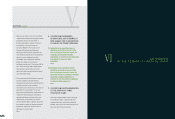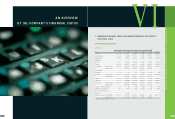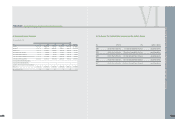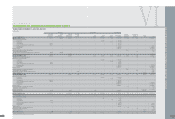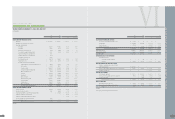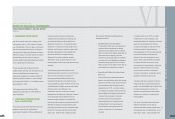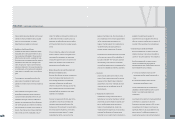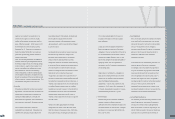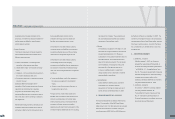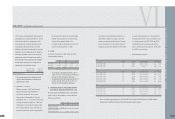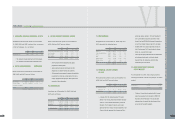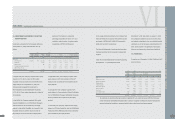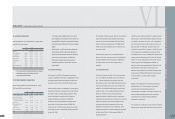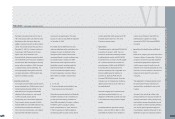HTC 2007 Annual Report Download - page 58
Download and view the complete annual report
Please find page 58 of the 2007 HTC annual report below. You can navigate through the pages in the report by either clicking on the pages listed below, or by using the keyword search tool below to find specific information within the annual report.
111110
AN OVERVIEW OFTHE COMPANY'S FINANCIAL STATUS
Th
e
Comp
a
ny's s
i
gn
i
f
i
c
a
n
t
a
cc
oun
t
i
ng po
li
c
i
e
s
a
r
e
summ
a
r
i
z
e
d
a
s
f
o
ll
ows
:
> Curr
e
n
t
/Non
c
urr
e
n
t
Ass
e
t
s
a
nd L
i
a
b
ili
t
i
e
s
Current assets include cash, cash equivalents,
and those assets held primarily for trading
purposes or to be realized, sold or consumed
within one year from the balance sheet date. All
other assets such as property, plant and
equipment and intangible assets are classified
as noncurrent. Current liabilities are obligations
incurred for trading purposes or to be settled
within one year from the balance sheet date. All
other liabilities are classified as noncurrent.
>
F
i
n
a
n
c
i
a
l
Ass
e
t
s/L
i
a
b
ili
t
i
e
s
a
t
Fa
i
r V
a
l
u
e
t
hrough
Pro
f
i
t
or Loss
Financial instruments classified as financial
assets or financial liabilities at fair value through
profit or loss (FVTPL) include financial assets or
financial liabilities held for trading and those
designated as at FVTPL on initial recognition.
The Company recognizes a financial asset or a
financial liability in the balance sheet when the
Company becomes a party to a financial
instrument contract. A financial asset is
derecognized when the Company loses its
contractual rights to the financial asset. A
financial liability is derecognized when the
relevant contract ends or is discharged or
canceled.
Financial instruments at FVTPL are initially
measured at fair value. Transaction costs
directly attributable to the acquisition of financial
assets or financial liabilities at FVTPL are
recognized immediately in profit or loss. After
the initial recognition, financial assets or
financial liabilities at FVTPL are remeasured at
fair value at the balance sheet date, with
changes in fair value recognized as current
gains or losses. Cash dividends received are
recognized as income for the year. On the
derecognition of a financial asset or a financial
liability, the difference between its carrying
amount and the sum of the consideration
received or receivable or consideration paid or
payable is recognized as gain or loss.
A derivative that does not meet the criteria for
hedge accounting is classified as a financial
asset or a financial liability held for trading. If the
fair value of the derivative is positive, the
derivative is recognized as a financial asset;
otherwise, the derivative is recognized as a
financial liability.
Fair values of financial assets and financial
liabilities at the balance sheet date are
determined as follows: publicly traded stocks - at
closing prices; open-end mutual funds - at net
asset values; bonds - at prices quoted by the
VI
1.ORGANIZATION AND OPERATIONS
High Tech Computer Corp. (the "Company") was
incorporated on May 15, 1997 under the Company
Law of the Republic of China to design, manufacture
and sell converged handheld devices. In 1998, the
Company had an initial public offering and, in March
2002, the Company's stock was listed on the Taiwan
Stock Exchange. On November 19, 2003, the
Company started trading Global Depositary Receipts
on the Luxembourg Stock Exchange.
To have synergies with companies in similar
industries, lower operating costs and expenses, and
enhance competitiveness and research and
development capabilities, the Company's Board of
Directors proposed on October 31, 2003 to merge
the Company with IA Style, Inc. The effective merger
date was March 1, 2004.
The Company had 4,108, 4,590 and 5,569
employees as of December 31, 2005, 2006 and
2007, respectively.
2.SIGNI
F
ICANT ACCOUNTING POLICIES
BASIS O
F
PRESENTATION
The accompanying financial statements have been
prepared in conformity with the Guidelines
Governing the Preparation of Financial Reports by
Securities Issuers, Business Accounting Law,
Guidelines Governing Business Accounting, and
accounting principles generally accepted in the
Republic of China (R.O.C.). In preparing financial
statements in conformity with these guidelines and
principles, the Company is required to make certain
estimates and assumptions that could affect the
amounts of allowance for doubtful accounts,
allowance for inventory devaluation, property
depreciation, royalty, accrued pension cost, and
warranty liability. Actual results could differ from these
estimates.
The accompanying financial statements were
originally presented in more than one set of Chinese
reports. For the convenience of readers, the
accompanying financial statements have been
translated into English from the original Chinese
version prepared and used in the ROC. If there is any
conflict between the English version and the original
Chinese version or any difference in the
interpretation of the two versions, the Chinese-
language financial statements shall prevail. However,
the accompanying financial statements do not
include the English translation of the additional
footnote disclosures that are not required under ROC
generally accepted accounting principles but are
required by the Securities and Futures Bureau (SFB,
formerly the "Securities and Futures Commission"
before July 1, 2004) for their oversight purposes.
H I G H T E C H C O M P U T E R C O R P.
NOTES TO
F
INANCIAL STATEMENTS
YEARS ENDED DECEMBER 31, 2005, 2006 AND 2007
(In Thousands)



